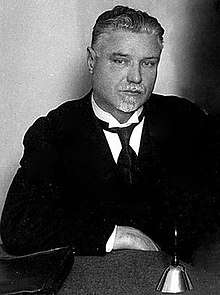Pauls Kalniņš
Pauls Kalniņš (born 3 March 1872 in Vilce Parish, died on 26 August 1945 in Lustenava, Austria) was a Latvian physician and politician (LSDSP), a long-term Speaker of the Saeima, one of the signatories of the Memorandum of the Central Council of Latvia in 17 March 1944, and was the Acting President of Latvia (1944–1945).
Pauls Kalniņš | |
|---|---|
 | |
| Speaker of the Saeima | |
| In office 20 March 1925 – 15 May 1934 | |
| President | Jānis Čakste Gustavs Zemgals Alberts Kviesis |
| Prime Minister | Hugo Celmiņš Kārlis Ulmanis Arturs Alberings Marģers Skujenieks Pēteris Juraševskis Hugo Celmiņš (2nd term) Kārlis Ulmanis (3nd term) Marģers Skujenieks (2nd term) Ādolfs Bļodnieks |
| Deputy | Kārlis Pauluks Jāzeps Rancāns Juris Pabērzs Alberts Kviesis Arturs Alberings Margers Skujenieks[1] |
| Preceded by | Frīdrihs Vesmanis |
| Succeeded by | Position abolished |
| 2nd President of Latvia | |
| In office 14 March 1927 – 8 April 1927 As Acting President | |
| Prime Minister | Marģers Skujenieks |
| Preceded by | Jānis Čakste |
| Succeeded by | Gustavs Zemgals |
| Personal details | |
| Born | 3 March 1872 Vilce Parish, Dobele District, Kurzeme, Russia |
| Died | 26 August 1945 (aged 73) Lustenava, French-occupied Austria (now Vorarlberg, Austria) |
| Nationality | Latvian |
| Political party | LSDSP |
| Spouse(s) | Klāra Kalniņa |
| Children | Brūno Kalniņš |
| Alma mater | University of Tartu |
| Profession | Doctor |
Personal life
Pauls Kalniņš was born on 3 March 1872[2][3][4] (from other sources – 3 April[5]) at the Vilce Parish "Mazpečuļos" as a farmer's son. After graduating from the local parish school, he studied at Liepāja Gymnasium,[5] where he met such later statesmen such as Miķelis Valters and Jānis Jansons-Brauns. He graduated from the gymnasium in 1892 and went to study natural sciences at Moscow University, but later moved to the University of Tartu, where he studied medicine, obtaining a medical degree as a Doctor of Medicine in 1898. He met his wife, Klāra Kalniņa, in 1895, and married her three years after.
Political career
As a member of the Pīkalkalonia, in 1897, he was arrested together with other members of the New Current and deported from Latvia until 1901. The deportation was accompanied by Žagarė . After returning to Latvia, he became a prominent member of the Social Democrats, a participant in the 1905 Russian Revolution, and was a collaborator in the editorial staff of Cīņa, Neatkarīgā Cīņa (now Neatkarīgā Rīta Avīze). He joined the non-Bolshevik direction of social democracy. He became a Chairman of the LSDSP Central Committee (1918–1924), a member of the People's Council, a member of the Constitutional Assembly and a member of all the first free state Saeima, as a Chairman of the 1st, 2nd, 3rd and 4th Saeima. According to K. Ulmanisspent, he spent 4 months in prison after the coup. According to the Constitution of Latvia, as the last Speaker of the Saeima, he was the acting president until his death.[6][7] For this and other reasons, during the German occupation, Kalniņš was one of the founders of the Latvian Central Council.[8]
Kalniņš ran in the Latvian presidential elections of 1930 and 1933. On both occasions, he lost to Alberts Kviesis.[9]
At the meeting of the Central Council of Latvia on 8 September 1944, Kalniņš signed a declaration on the restoration of the Latvian state: "On the basis of the Satversme of the Republic of Latvia (Article 52), the position of the last President of the Saeima has passed to me as the last legally elected Speaker of the Saeima. On this day, I took up the position of the President until the election of a new President in accordance with the procedure provided for in the Satversme. [..] "[10]
Death
In 1944 he emigrated. He died on 26 August 1945 in the village of Becava near Lustenava, in the Allied occupied Austria.[6]
He was survived by his wife Klāra Kalniņa and son Brūno Kalniņš, who were also notable employees of the Social Democrats.
References
- Saeimas stenogrammas (from 1925 to 1934) (in Latvian). periodika.lv.
- Ērglis, Artis (2005). "Kalniņš Pauls". Personu rādītāji, letonika.lv.
- Kalniņš Pauls (in Latvian). 4. Riga: Latvian Soviet Encyclopedia. 1983. p. 577.
- Saeimas stenogrammas, IX sesija (from April 27, 1934 – May 15, 1934) (in Latvian). Saeima.
- "Pauls Kalnins". Saeima. 30 October 2008. Archived from the original on 30 October 2008.
- Bulmanis, Nikolajs. "LUSTENAVAS VASARA". Jaunā Gaita, zagarins.net.
- Pleps, Jānis (6 June 2008). "Pazudušais prezidents". politika.lv.
- "Latviešu Centrālās padomes un Latviešu Centrālās komitejas pirmsākumi". vestnesis.lv.
- "Alberts Kviesis". president.lv. Archived from the original on 24 September 2015.
- "Latvijas Centrālā Padome". historia.lv. 12 February 2012. Archived from the original on 12 February 2012.